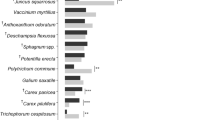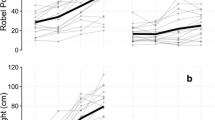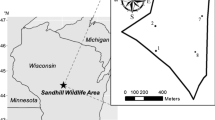Abstract
Fender’s blue butterfly is an endangered species restricted to fragmented, grassland remnants that are becoming increasingly dominated by tall, invasive grasses in western Oregon, USA. I performed a removal experiment to assess the impacts of structural degradation accompanying the invasion of Arrhenatherum elatius, tall oat grass, on butterfly fitness and fitness related behaviors. Clipping of A. elatius to native grass sward height resulted in 2.5–5 times as many eggs laid per leaf of host plant. Both male and female butterflies basked more frequently in areas removed of A. elatius inflorescences and upon encountering the treatment edge butterflies had a high rate of return into a large area removed of the grass inflorescences. Although butterfly behavior appeared to be affected by the change in sward height on the treatment edge, there was no evidence for the edge causing a disproportionate egg load. Invasion and dominance by A. elatius appeared to diminish host plant apparency which may result in overloading of eggs on conspicuous host plants, increased incidence of emigration, and a decrease in the likelihood of colonization because female butterflies appeared indifferent to larval resources beneath A. elatius inflorescences. Dominance of natural shortgrass prairies by tall stature grasses like A. elatius may be an insidious form of habitat degradation for grassland Lepidoptera worldwide, but it may go largely unnoticed because larval and adult resources can persist under the unnaturally tall grass canopy.





Similar content being viewed by others
References
Baumann DT, Bastiaans L, Kropff MJ (2001) Effects of intercropping on growth and reproductive capacity of late-emerging Senecio vulgaris L., with special reference to competition for light. Ann Bot 87:209–217
Berwaerts K, Van Dyck H (2004) Take-off performance under optimal and suboptimal thermal conditions in the butterfly Pararge aegeria. Oecologia 141:536–545
Betzholtz P (2003) Habitat utilization by ovipositing females and larvae in an endangered population of moth Dysauxes ancilla (Lepidoptera:Ctenuchidae). J Res Lepid 37:47–54
Clench HK (1966) Behavioral thermoregulation in butterflies. Ecology 47:1021–1034
Collinge SK, Prudic KL, Oliver JC (2003) Effects of local habitat characteristics and landscape context on grassland butterfly diversity. Conserv Biol 17:178–187
Dennis RLH, Hodgson JG, Grenyer R, Shreeve TG, Roy DB (2004) Host plants and butterfly biology. Do host-plant strategies drive butterfly status? Ecol Entomol 29:12–26
DeVries PJ, Walla TR, Greeney HF (1999) Species diversity in spatial and temporal dimensions of fruit-feeding butterflies from two Ecuadorian rainforests. Biol J Linn Soc 68:333–353
Dover JW, Fry GLA (2001) Experimental simulation of some visual and physical components of a hedge and the effects of butterfly behavior in an agricultural landscape. Entomol Exp Appl 100:221–233
Dover JW, Rowlingson B (2005) The western jewel butterfly (Hypochrysops halyaetus): factors affecting adult butterfly distribution within native Banksia bushland in an urban setting. Biol Conserv 122:599–609
Ellis S (2003) Habitat quality and management for the northern brown argus butterfly Aricia artaxerxes (Lepidoptera: Lycaenidae) in north east England. Biol Conserv 113:285–294
Floater GJ, Zalucki MP (2000) Habitat structure and egg distributions in the processionary caterpillar Ochrogaster lunifer: lessons for conservation and pest management. J Appl Ecol 37:87–99
Graham SA, Turkington R (2000) Population dynamics response of Lupinus arcticus to fertilization, clipping, and neighbour removal in the understory of the boreal forest. Can J Bot 78:753–758
Haddad NM (1999) Corridor use predicted from behaviors at habitat boundaries. Am Nat 153:215–227
Heinrich B (1986) Thermoregulation and flight activity of a satyrine, Coenonympha inornata (Lepidoptera: Satyridae). Ecology 76:593–597
Ide J (2002) Seasonal changes in the territorial behavior of the satyrine butterfly Lethe diana are mediated by temperature. Ethology 20:71–78
Karban R (1997) Neighbourhood affects a plant’s risk of herbivory and subsequent success. Ecol Entomol 22:433–439
Kopper BJ, Charlton RE, Margolies DC (2000) Oviposition site selection by the regal fritillary, Speyeria idalia, as affected by proximity of violet host plants. J Insect Behav 13:651–665
Lederhouse RC (1982) Territorial defense and lek behavior of the black swallowtail butterfly Papilio polyxenes. Behav Ecol Sociobiol 10:109–118
Liancourt P, Callaway RM, Michalet R (2005) Stress tolerance and competitive-response ability determine the outcome of biotic interactions. Ecology 86:1611–1618
Maes D, Van Dyck H (2001) Butterfly diversity loss in Flanders (north Belgium): Europe’s worst case scenario? Biol Conserv 99:263–276
Mouquet N, Thomas JA, Elmes GW, Clarke RT, Hochberg ME (2005) Population dynamics and conservation of a specialized predator: a case study of Maculinea arion. Ecol Monogr 75:525–542
Munguira ML, Thomas JA (1992) Use of road verges by butterfly and burnet populations, and the effects of roads on adult dispersal and mortality. J Appl Ecol 29:316–329
Pfitzenmeyer CDC (1962) Biological flora of the British Isles: Arrhenatherum elatius (L.) J & C Presl. J Ecol 50:235–245
Pilson D, Rausher MD (1988) Clutch size adjustment by a swallowtail butterfly. Nature 333:361–363
Pollard E, Woiwood IP, Greatorex-Davies JN, Yates TJ, Welch RC (1998) The spread of coarse grasses and changes in numbers of lepidoptera in a woodland nature reserve. Biol Conserv 84:17–24
Price PW (1991) The plant vigor hypothesis and herbivore attack. Oikos 62:244–251
Ramsey FL, Schafer DW (2002) The statistical sleuth: a course in methods of data analysis 2nd ed. DUXBURY Pacific Grove, California, p 742
Ries L, Debinski DM (2001) Butterfly responses to habitat edges in the highly fragmented prairies of central Iowa. J Anim Ecol 70:840–852
Rutowski RL (2000) Postural changes accompany perch location changes in male butterflies (Asterocampa leilia) engaged in visual mate searching. Ethology 106:453–466
Scott JA (1986) The butterflies of North America. Stanford University Press, Stanford, CA, p 583
Schultz CB, Crone EE (2001) Edge-mediated dispersal behavior in a prairie butterfly. Ecology 82:1879–1892
Schultz CB, Hammond PC (2003) Using population viability analysis to develop recovery criteria for endangered insects: case study of the Fender’s blue butterfly. Conserv Biol 17:1372–1385
Schultz CB, Hammond PC, Wilson MV (2003) Biology of the Fender’s blue butterfly, an endangered species of western Oregon native prairies. Nat Area J 23:61–71
Severns P (2003a) Inbreeding and small population size reduce seed set in a threatened and fragmented plant species, Lupinus sulphureus ssp. kincaidii (Fabaceae) Biol Conserv 110:221–229
Severns PM (2003b) Propagation of a long-lived and threatened prairie plant, Lupinus sulphureus ssp. kincaidii Restor Ecol 11:334–342
Severns PM, Villegas S (2005) Butterflies hanging on to existence in the Willamette Valley: a relict population of the great copper (Lycaena xanthoides Boisduval). Northwest Sci 79:77–80
Severns PM, Boldt L, Villegas S (2006) Conserving a wetland butterfly: quantifying early lifestage survival through seasonal flooding, adult nectar, and habitat preference. J Insect Conserv 10:361–370
Shields O (1967) Hilltopping. J Res Lepid 6:69–178
Shreeve TG (1986) Egg-laying by the speckled wood butterfly Pararge aegeria: the role of female behavior, host plant abundance and temperature. Ecol Entomol 11:229–236
Stiling P (1988) Density-dependent processes and key factors in insect populations. J Anim Ecol 57:581–593
Stutt AD, Willmer P (1998) Territorial defense in speckled wood butterflies: do the hottest males always win? Anim Behav 55:1341–1347
Summerville KS, Veech JA, Crist TO (2002) Does variation in patch use among butterfly species contribute to nestedness at fine spatial scales? Oikos 97:195–204
Thomas CD, Jones TM (1993) Partial recovery of a skipper butterfly (Hesperia comma) from population refuges: lessons for conservation in a fragmented landscape. J Anim Ecol 62:472–481
Thomas JA (1983) The ecology and conservation of Lysandra bellargus (Lepidoptera: Lycaenidae) in Britain. J Appl Ecol 20:59–83
Thomas JA, Thomas CD, Simcox DJ, Clarke RT (1986) Ecology and declining status of the silver spotted skipper butterfly (Hesperia comma) in Britain. J Appl Ecol 23:365–380
Thomas JA, Bourn NAD, Clarke RT, Stewart KE, Simcox DJ, Pearman GS, Curtis R, Goodger B (2001) The quality and isolation of habitat patches both determine where butterflies persist in fragmented landscapes. Proc Roy Soc B-Biol Sci 268:1791–1796
Watt WB (2003) Mechanistic studies of butterfly adaptation. In: Boggs CL, Watt WB, Ehrlich PR (eds) Butterflies: ecology and evolution taking flight. University of Chicago Press, Chicago, pp 319–352
Weiss SB (1999) Cars, cows, and checkerspot butterflies: nitrogen deposition and management of nutrient-poor grasslands for a threatened species. Conserv Biol 13:1476–1486
White TCR (1984) The abundance of invertebrate herbivores in relation to the availability of nitrogen in stressed food plants. Oecologia 63:90–105
Wiklund C (1977) Oviposition, feeding and spatial separation of breeding and foraging habitats in a population of Leptidea sinapis (Lepidoptera). Oikos 28:56–68
Wiklund C (1984) Egg laying patterns in butterflies in relation to their phenology and visual apparency and abundance of their host plants. Oecologia 63:23–29
Williams EH (1981) Thermal influences on oviposition in the montane butterfly Euphydryas gillettii. Oecologia 50:342–346
Wilson BL (1997) A “new” native fescue of western Oregon prairies. In: Kaye TN, Liston A, Love RM, Luoma DL, Meinke RJ, Wilson MV (eds) Conservation and management of native plants and fungi. Native Plant Society of Oregon, OSU Bookstore Printing, Corvallis, pp 153–161
Wilson MV, Clark DL (2001) Controlling invasive Arrhenatherum elatius and promoting native prairie grasses through mowing. Appl Veg Sci 4:129–138
Wilson MV, Erhart T, Hammond PC, Kaye TN, Kuykendall K, Liston A, Robinson Jr AF, Schultz CB, Severns PM (2003) Biology of Kincaid’s lupine (Lupinus sulphureus ssp. kincaidii [Smith] Phillips), a threatened species of western Oregon native prairies Nat Areas J 23:72–83
Zalucki MP, Clarke AR, Malcolm SB (2002) Ecology and behavior of first instar larval Lepidoptera. Ann Rev Entomol 47:361–393
Acknowledgements
I thank J. Beal and W. Messinger (U.S. Army Corps of Engineers) for access to the study sites, S. McKnight for helping prepare treatment plots, C. Benfield for aiding in the recording of butterfly behavior, and L. Sanders and B. Lewis for their help with egg counts. C. B. Schultz, A. Liston, and two anonymous reviewers provided comments that helped improve this manuscript.
Author information
Authors and Affiliations
Corresponding author
Rights and permissions
About this article
Cite this article
Severns, P.M. Exotic grass invasion impacts fitness of an endangered prairie butterfly, Icaricia icarioides fenderi . J Insect Conserv 12, 651–661 (2008). https://doi.org/10.1007/s10841-007-9101-x
Received:
Accepted:
Published:
Issue Date:
DOI: https://doi.org/10.1007/s10841-007-9101-x




